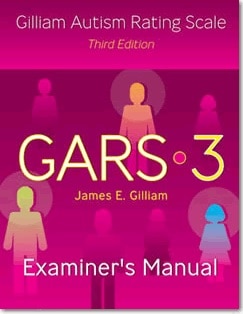GARS-3 Gilliam Autism Rating Scale 3rd Edition, 自閉症評定尺度, 第3版

Purpose: Helps you identify and diagnose autism
Age range: 3 years to 22 years
Format: Paper and pencil
Time: 5-10 minutes
Qualification level: B
Test structure
Technical information
Age range: 3 years to 22 years
Format: Paper and pencil
Time: 5-10 minutes
Qualification level: B
※本商品をご購入いただくにあたり、Qualification Formへご記入していただくことになっております。予めご了承下さいますようお願い申し上げます。
Description
Features and benefits
- Items and subscales reflect DSM-5™ diagnostic criteria for autism spectrum disorder.
- Items are grouped into three subscales—Stereotyped Behaviors, Communication, and Social Interaction.
Test structure
- - Fifty-six clearly stated items describe the characteristic behaviors of persons with autism and are grouped into six subscales: Restrictive, Repetitive Behaviors, Social Interaction, Social - Communication, Emotional Responses, Cognitive Style, and Maladaptive Speech.
- An interpretation guide allows the examiner an easy and efficient method for assessing the probability and severity of autism spectrum disorder.
Technical information
- - Internal consistency reliability coefficients exceed .85 for the subscales, .93 for the Autism Indexes; test-retest reliability coefficients exceed .80 for subscales and .90 for the Autism Indexes.
- - Correlations of the GARS-3 scores with those of other well-known diagnostic tests for autism are large or very large in magnitude.
- - Binary classification studies indicate that the GARS-3 is able to accurately discriminate children with autism spectrum disorder from children without autism (i.e., sensitivity = .97, specificity = .97, ROC/AUC = .93).
- - Normative data (N = 1,859) were collected in 2010 and 2011. Demographic characteristics of the normative sample are representative of 2011 U.S. Census statistics.










